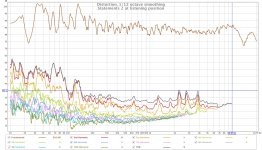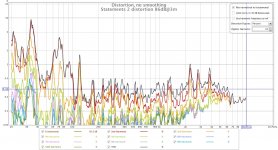Electronics and amps are for the most part transparent.
You see, my research would indicate that the exact opposite is true. That electronics can have seriously degrading nonlinearities that loudspeakers can't have.
subjectively, I've thought of near-field as being too close to use multi-way speakers due to poor integration of the sound.
The term "near field" is a scientific one, not a subjective one. It seems to me that it is best not to tromp on an existing definition with a new one that is just based on how one person defines it.
Make up a new term and see if it catches on!
You see, my research would indicate that the exact opposite is true. That electronics can have seriously degrading nonlinearities that loudspeakers can't have.
This might have been true 40 years ago. In case it is measured on current designs, they must be extremely poor then. In fact, all the distortion products of a well designed amplifier lie 40dB or lower below distortion products of the good speaker. No problem to get absolutely negligible high order distortion from well engineered amp. No problems with small signals as well. There is no good amp with transfer curve like the No.2 with discontinuity like in your AES distortion paper, part II.
Re speaker nonlinear distortion, the best SOTA source is IMO Wolfgang Klippel
Separated loudspeaker distortion
Separated loudspeaker distortion
I hope that designers have gotten better, but I know that years ago when I looked at the high order distortion of some common amps using a unique test that I devised to look at the harmonics even below the noise floor, I found that several did have high levels of higher order distortion at very low signal levels - i.e. clear evidence of crossover anomalies. The problem is that by the common measurements of that time, THD+Noise, these distortions were never seen, they simply weren't measured.
I am well aware of Klippel's work, but he doesn't show the audibility of the different sources in blind tests. As I said, the experts at JBL do not believe that loudspeaker distortion is a real issue. Toole does not even mention it in his books. I'm just saying that this is my experience as well. Loudspeakers CAN have audible nonlinear distortion, but they can be designed to not have as well - just like amplifiers. I choose to NOT have distortion.
The real point is that there simply is no valid metric to do comparisons, so how does one even judge marginal cases?
I am well aware of Klippel's work, but he doesn't show the audibility of the different sources in blind tests. As I said, the experts at JBL do not believe that loudspeaker distortion is a real issue. Toole does not even mention it in his books. I'm just saying that this is my experience as well. Loudspeakers CAN have audible nonlinear distortion, but they can be designed to not have as well - just like amplifiers. I choose to NOT have distortion.
The real point is that there simply is no valid metric to do comparisons, so how does one even judge marginal cases?
I'm doing my best, well, me n DaveMake up a new term and see if it catches on!
subjectively, I've thought of near-field as being too close to use multi-way speakers due to poor integration of the sound. As soon as I'm far enough that a multi-way speaker sounds coherent then I'm no longer in the near-field. For computer speakers, single driver full-range is the way to go.
I've found that to be the case, there is something about a point source that stays composed well in the nearfield.
My current near field speakers use a mid tweet and a woofer, each covers about 6 octaves. Then they overlap from 500-1700 hz at -3db each. I use a PC for the crossover, really no other way to pull it off.
Bottom line it sounds like a single driver playing but with more extension into the highs and lows.
You could try series crossovers, but I agree that crossover with software based DSP is more precise and cost effective. This is the reason I am looking into 6~7 inch full range design. It is really tough. I have 3” working much close to where I think hard to improve on when placed against a wall, but it requires a steep filter to cut off at 40 Hz to work well at most reasonable levels.
Last edited:
Here's a measurement of a single speaker in my room.
Room size- 8.2 x 6.4 x 2.6 metres (27' x 21' x 8.5')
Measurement distance- 3 metres (10')
SPL values are absolute, not relative.
The blue marker represents my average noise floor, which is around 35-45dB(A), depending on time of day (night-quieter; day- noisier) or environmental noises (AC, fan, outside birds or rustling of leaves)
Can I, or can't I hear the distortion?
Room size- 8.2 x 6.4 x 2.6 metres (27' x 21' x 8.5')
Measurement distance- 3 metres (10')
SPL values are absolute, not relative.
The blue marker represents my average noise floor, which is around 35-45dB(A), depending on time of day (night-quieter; day- noisier) or environmental noises (AC, fan, outside birds or rustling of leaves)
Can I, or can't I hear the distortion?
An externally hosted image should be here but it was not working when we last tested it.
Last edited:
Very low distortion. Well behaved 2nd and 3rd harmonics (3rd stays under 2nd) that helps SQ.
Although sort of near-field, very flat FR north of 300 Hz to as far as HiFi for humans needs to go. But bass still oddly variable at 1/12 smoothing.
What're the components, esp the speakers and crossover parameters?
(REW now can plot HD re fundamental. Can't make up my mind if that's more meaningful to my eye than traditional plot.)
B.
Although sort of near-field, very flat FR north of 300 Hz to as far as HiFi for humans needs to go. But bass still oddly variable at 1/12 smoothing.
What're the components, esp the speakers and crossover parameters?
(REW now can plot HD re fundamental. Can't make up my mind if that's more meaningful to my eye than traditional plot.)
B.
Last edited:
You could try series crossovers, but I agree that crossover with software based DSP is more precise and cost effective. This is the reason I am looking into 6~7 inch full range design. It is really tough. I have 3” working much close to where I think hard to improve on when placed against a wall, but it requires a steep filter to cut off at 40 Hz to work well at most reasonable levels.
Yeah I looked into series crossovers for a fast system, def possible. There's also things like mutual coupling that can elevate the frequency response around crossover. Using equalizer APO for the crossover lets me flatten the driver response anyways.
With a 6" I'd go with a subwoofer.
Here's a measurement of a single speaker in my room.
Can I, or can't I hear the distortion?
Yes, I don't think there are many speakers in the world without some form of audible distortion. The cone has mass and can never perfectly reproduce the signal. Speaker distortion is much more complicated than electronics.
As far as non linear distortion goes I don't know, because a lot depends on the type. I've heard around .5% is very good, esp if its mostly 2nd harmonic.
They say with amps around .1% is a good target, but keep in mind that the transistor distortion in amps is relatively more audible than other types.
Last edited:
Here's a measurement of a single speaker in my room.
Room size- 8.2 x 6.4 x 2.6 metres (27' x 21' x 8.5')
Measurement distance- 3 metres (10')
SPL values are absolute, not relative.
The blue marker represents my average noise floor, which is around 35-45dB(A), depending on time of day (night-quieter; day- noisier) or environmental noises (AC, fan, outside birds or rustling of leaves)
Can I, or can't I hear the distortion?
An externally hosted image should be here but it was not working when we last tested it.
I can't seem to open the image.
A decent overview of audio distortion can be found here:
Types of Audio Distortion
He says that IMD is much more of an issue that harmonic. Also discusses audiblity.
Types of Audio Distortion
He says that IMD is much more of an issue that harmonic. Also discusses audiblity.
It was hosted by Dropbox.
Thanks for posting the normalized HD.
Actually, it nicely illustrates what's a problem with that display. Your FR has a giant dip at roughly 32 Hz, likely mostly due to an artifact of measurement rather than a speaker dip*. But the normalized HD has an enormous peak due to that illusory dip. All a good reason to use cosmetics in the form of some smoothing since the fine-grain of HD isn't meaningful.
Again, really nice results. Again, what is the gear?
B.
*even if it is true speaker dip the absolute level of distortion products are low and the critique to follow still applies
Last edited:
Hi Earl,
It was hosted by Dropbox. Strange, it was working the yesterday.
I'll upload to DIYaudio instead.
It appears to me that the distortion is dominated by 2nd order which is heavily masked, so I would say that in all likelihood this amount of nonlinear distortion would not be significant. But again, its hard to tell since we have no perceptually valid metric for nonlinear distortion.
As an aside looking at the graph I wonder when did it become acceptable to mix terminology?
Technically there is no 'fundamental' in a harmonic series but there is in the overtone series ie what is called fundamental and 2nd harmonic in the graph should be called either 1st and 2nd harmonic or fundamental and 1st overtone.
Technically there is no 'fundamental' in a harmonic series but there is in the overtone series ie what is called fundamental and 2nd harmonic in the graph should be called either 1st and 2nd harmonic or fundamental and 1st overtone.
Yes, been wondering about that myself for a while. But like many evolutions in living language, it might work fine within the REW world.Technically there is no 'fundamental' in a harmonic series...
I've taken it to mean the recorded sound less the crap. In practice in the loose world of eyeballing charts with less than monumental distortion, that would be the same as simply thinking of the recording as the "fundamental" and so the exact definition, to me, becomes moot.
B.
The problem is it's commonly used (ie not scientifically) as meaning.........what? The monitors on a mixing desk are often referred to as near field....for exampleThe term "near field" is a scientific one, not a subjective one.
Near field implies reflections are negligible, and no air HF attenuation.
Often that means something like speakers are placed in a triangular arrangement, 3 feet apart, 3 feet from the listener, and toed in to point at the listener's ears. Low volume levels tend to help too. Not the only way to do it though.
Often that means something like speakers are placed in a triangular arrangement, 3 feet apart, 3 feet from the listener, and toed in to point at the listener's ears. Low volume levels tend to help too. Not the only way to do it though.
- Home
- Loudspeakers
- Multi-Way
- Who makes the lowest distortion speaker drivers

